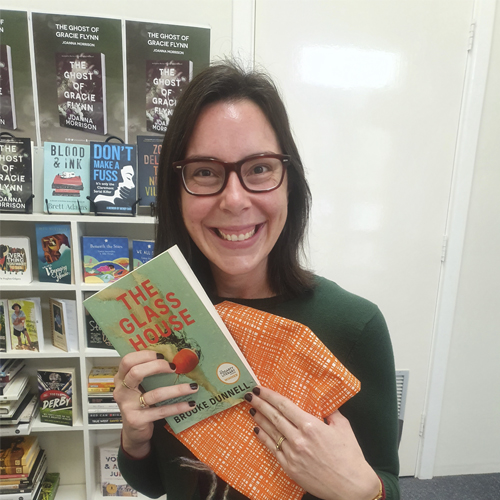Fogarty winner Brooke Dunnell shares her love of storytelling with the Cocos (Keeling) Islands

An article by Brooke Dunnell, author of The Glass House.
Before my trip, everyone who hears that I’m going to the Cocos (Keeling) Islands is thrilled and mildly jealous. They google the overseas territory and gasp at images of clean white sand, a tranquil blue-green lagoon and dense queues of coconut palms. In July and August, Perth is cold, with bleak days of rain. ‘You’re going there?’ they ask in wonder.
I’m visiting the Cocos (Keeling) Islands for three nights as part of winning the 2021 Fogarty Literary Award, which, along with its $20,000 cash prize, funds the winner to present writing workshops to regional schools. When the expression of interest was sent out, Cocos (Keeling) Islands District High School’s librarian responded that she was very interested, but was probably on the wrong mailing list, given the remoteness of the islands. But it’s that same remoteness that makes CKIDHS an excellent place for an author visit, with the Fogarty Foundation supporting authors to reach students as far and wide as they can.
There are only two flights a week from Perth to the Islands, with stopovers in either Learmonth or Christmas Island on the way up. The settlement on West Island, where the airport is located, directs a lot of activity towards the arrival and departure of the plane, and I land to all the hustle, bustle and excitement the island has to offer. Salty’s Bakery is pumping out pizzas and loaves of bread (I get one of each), and the Cocos Club is crowded and festive, with people smiling and greeting one another all around. I’m delighted by the warm breeze after wintery Perth. Lee, the school librarian and my host, tells me she’s been on island for over twelve years across two different stints, and there’s no place like it. Heaven.
To allow me to work with as many students as possible, Lee organises for me to visit CKIDHS’s West Island campus for one full day and Home Island, across the lagoon, on the following day. The West Island campus goes up to Year 10, and while I’m there I join the Year 9–10 class twice, the Years 7–8 for two hours, and spend an hour with the Years 3–6.
With my trip occurring ahead of the school’s celebration of Book Week, I aim to ease students into storytelling mode by giving them the opportunity to write a story in a day. Using Aesop’s fable The Boy Who Cried Wolf as a model, I lead the students through the main structural elements of narrative fiction: the exposition, where we meet the characters and learn about the setting; introduction of the conflict or complication; the development of rising tension as the characters face the problem or opportunity; the climax, where the efforts culminate; and the resolution, with life returning to normal – or not.
Once a group is familiar with the narrative arc, they start on their own stories. For younger groups, this involves writing an exposition based on their life before being presented with a conflict at random, such as discovering a strange object in the fridge, receiving a mysterious letter, or hearing sudden cries for help. For the older kids, they create a character inspired by a set of images, then brainstorm the type of conflict they could face. The students enjoy this part especially, throwing options at me faster than I can copy them on the board: zombies, skeletons and vampires. Flowers raining from the sky. Meeting a new friend.
The next day, on Home Island, I talk through a group story with the Years 1–2, and their suggestions are even wilder. Will a plane fly through the classroom? Maybe one million cats might stampede us? Ultimately, a group vote decides a giant warthog should crash through the ceiling over their teacher’s desk and chase us around, then wee on the floor when we hide. (Perhaps unsurprisingly, the kids also want to act this out, with an especially enthusiastic student playing the warthog to the thrill of his classmates.)
After presenting the workshop to Home Island’s Years 3, 4 and 5–6 classes, my program is finished. Exhilarated and exhausted, I spend the last couple of hours before the trip back to West Island exploring the grounds of Oceania House, then dipping my feet in the crystal water of the lagoon and watching fish. People passing on quad bikes and golf carts wave heartily, though we’ve never met.
From the ferry, the bus driver drops me right in front of my accommodation, and two teachers I met earlier suggest I head to the ocean beach at dusk to spot sharks. I venture out at half-past five, walking north along the sand and watching for the tiny white crabs that scurry between the rocks. Thinking I must have missed the fins, I’m just turning to go back when I see the reef sharks right in front of me, their smooth, jelly-like bodies cutting through the water so close to shore it’s a wonder they don’t scrape their soft bellies on the sand.
The Cocos (Keeling) Islands really are another world. Wild roosters roam, crowing at whatever time of day they feel like it. Coconuts hang overhead, falling in such numbers that in some places their shells carpet the ground. During dinner at a restaurant, a gecko trots lazily across our outdoor table. The locals compare sightings of the two rabbits said to live on West Island. On the day I leave, saying goodbye leads to many invitations to return.
My greatest joy, however, is hearing about a teacher’s son who’d been in one of my classes the previous day and went home raving with pride about the story he wrote. “He doesn’t usually like writing,” I learned. “His dad was absolutely chuffed.” Almost as chuffed as me.


